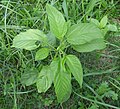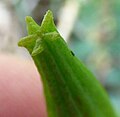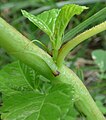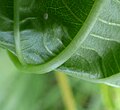Corchorus olitorius
| Corchorus olitorius | |
|---|---|
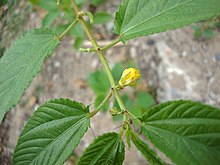
| |
| Scientific classification | |
| Kingdom: | Plantae |
| Clade: | Tracheophytes |
| Clade: | Angiosperms |
| Clade: | Eudicots |
| Clade: | Rosids |
| Order: | Malvales |
| Family: | Malvaceae |
| Genus: | Corchorus |
| Species: | C. olitorius
|
| Binomial name | |
| Corchorus olitorius | |
| Synonyms[1] | |
| |
Jute mallow or Nalita jute (Corchorus olitorius, also known as "Jew's mallow",[2] "Tossa jute", "Bush okra", and "West African sorrel") is a species of shrub in the family Malvaceae. Together with C. capsularis it is the primary source of jute fiber.[3][4] The leaves and young fruits are used as a vegetable, the dried leaves are used for tea and as a soup thickener, and the seeds are edible.[3]
Origin and history
It is unclear whether Corchorus olitorius originated in Africa or in Asia. Some authorities consider that it comes from the Indo-Burmese area or from India, along with several other related species. Others point out that there is a greater genetic variation in Africa and a larger number of wild species in the genus Corchorus. Wherever it originated, it has been under cultivation for a very long time in both continents and probably grows, wild or as a crop, in every country in tropical Africa.[5]
In classical antiquity, Pliny recorded that jute plants were used as food in ancient Egypt.[6] It may have also been cultivated by the Jews in the Near East, which gives the plant its name.[6]
Botany
Corchorus olitorius is an erect herbaceous plant, fairly branched and grows about 1.5 m high. However, if grown for fibre production, it can reach heights up to 4 m. The taproot leads to a sturdy and hairless stem, which is green with a faint red-brownish hue and sometimes turns a little woody on ground level. The serrate acute leaves alternate, are 6 to 10 cm long and 2 to 4 cm wide. The plant carries the flowers solitary or in two-flowered cymes opposite of the leaf. The flowers sit on the end of a short stem, count 5 sepals, 5 petals and 10 free and yellow stamina. The fruit is spindle-shaped, dehiscent and divided into transversal sections through five valves. The fruit measures 2 to 8 cm in length and colors vary from greyish-blue to green or brownish-black. Every seed chamber contains 25 to 40 seeds, which sum up to 125 to 200 seeds per fruit.[4][7]
Cultivation
Corchorus olitorius is an annual crop. The plant grows well in the lowland tropics, ranging from warm temperate zones through tropical desert to wet forest life zones. It can tolerate an annual precipitation between 400 and 4290 mm (optimum 1000 mm per year
Plant protection
The most serious pests are nematodes from the genus
Harvest and yield performance
Harvest can begin after about six weeks:[8] The whole plant can be directly harvested (for jute production) or leaves are harvested by pruning several times during the vegetation period (for food production). The shoot regeneration highly depends on variety, soil fertility, adequate water supply and control of weeds and pests. Amount of pruned shoots and quality reduces with each harvest. Under farming conditions the yield usually reaches around 2.5 t per hectare of edible leaves. Under experimental conditions and with very high fertility application, yields of about 28 t per hectare have been reported.[13]
Post harvest and propagation
For fresh consumption the leaves should be stored above 8 °C (46 °F) and below 15 °C (59 °F). Low temperatures from 1 to 8 °C (34 to 46 °F) lead to browning of the leaves and too high storage temperatures are manifested in leaf yellowing.[16] To produce seeds, the fruits can be harvested six weeks after flowering. The dried capsules are threshed and can be stored for eight to twelve months in well sealed jars.[8][13] For storage, the moisture should be around nine percent.[13]
Biochemistry
Leaves
Leaves of Corchorus olitorius are mainly known to have rich sources of many chemical compounds. There are 17 active nutrients compounds in Jute leaves including protein, fat, carbohydrate, fiber, ash, calcium, potassium, iron, sodium, phosphorus, beta-carotene, thiamine, riboflavin, niacin and ascorbic acid.[17]
Seeds
According to a comparative analysis of major nutrients of Corchorus olitorius seeds showed that the protein content of the Corchorus olitorius has significantly increased after seed germination process where the sugar level has decreased in the studied seeds.[18] It can be seen from this study that the level of nutrients in the Corchorus olitorius seed changes during the germination process.
Future prospects
C. olitorius could be grown in a floating system with nutrient solution and could produce baby leaves, which would be interesting for the fresh cut leafy vegetable industry in Europe.[19]
Uses
Fibre and textile use
Many textiles are made of jute, such as yarn, twine, sacking, carpet backing cloth and other blended textiles. It is also used as raw material for cords and strings.[21]
In Africa and the Middle East, a different type is grown with the leaves and shoots being used for food while the fibre is considered of little importance.[5]
Culinary use
C. olitorius is cultivated in
In Nigeria and Zambia, the leaves are boiled to make a sticky, mucilaginous sauce which is served with balls of
Nutrition
The edible part of jute is its leaves. Richness in potassium, vitamin B6, iron, vitamin A and vitamin C make this crop particularly important, where people cover a high share of their energy requirement by micronutrient-poor staple crops. This vegetable is predominantly eaten in Africa and Asia. A traditional Syrian, Lebanese, Tunisian, Turkish Cypriot, Jordanian, Palestinian and Egyptian dish made of C. olitorius leaves is mulukhiyah.
Medicinal aspects
Consumption of the leaves is reported to be demulcent, deobstruent, diuretic, lactagogue, purgative, and tonic. It is also a folk remedy for aches and pains, dysentery, enteritis, fever, pectoral pains, and tumors.[22][23] Ayurvedics use the leaves for ascites, pain, piles, and tumors. Elsewhere the leaves are used for cystitis, dysuria, fever, and gonorrhea. The cold infusion is said to restore the appetite and strength.[24] It can act as an anti-inflammatory,[25] and it has gastroprotective properties.[25]
Gallery
-
Young leaves of jute prepared by cooking in Taiwan
-
Jute field
-
Jute plantation
-
Cultivation and processing
-
Drying the cane
-
Drying hanks
-
Transporting jute fibres by bicycle cart in Bangladesh
-
A soup containing mushroom and Corchorus olitorius leaves, served in Malolos, the Philippines, where the latter vegetable is known as saluyot.
-
Fruits and seeds
-
Botanical illustration of Corchorus olitorius
-
Edible leaves of Corchorus olitorius
Botanical gallery
-
Whole plant with fruit
-
Leaf shape and texture
-
Flower, yellow or white
-
Pointed sepals, bracts at stalk base, no epicalyx
-
Pointed sepals, flowers yellow, may be white
-
Many (20+) anthers
-
Fruit 10-edged (5 parts with sunken middles)
-
Fruit 5-tipped
-
Immature seed arrangement
-
Stipules filamenty
-
Stipules filamenty
-
Leaf base teeth pair filamenty
-
Annual stem base
-
Maturing ovary
-
Leaf underside
-
Veination
See also
- Mulukhiyah
- Corchorus
- Corchorus capsularis
- Jute
- Jute cultivation
- Kenaf
- Abutilon theophrasti
- Fakou
- Ewedu soup
References
- ^ "The Plant List: A Working List of All Plant Species". Retrieved 21 May 2015.
- ^ ISSN 0033-5525.
- ^ a b "Plants for future".
- ^ )
- ^ ISBN 9789057821479.
- ^ ISBN 0415927463.
- ^ "Corchorus olitorius - TILIACEAE". idao.cirad.fr. Retrieved 2017-12-03.
- ^ a b c d e "Food Plants international".
- ^ a b c d "Corchorus olitorius".
- ^ a b Duke, J. A. (1978). "The quest for tolerant germplasm [Agricultural crops, resistance, ecosystematics]". ASA Special Publication American Society of Agronomy. 32.
- ^ Buchanan, Rita (1987). A weaver's garden. Interweave Press.
- .
- ^ a b c d e Akoroda, M. O. (1988). "Cultivation of jute (Corchorus olitorius L.) for edible leaf in Nigeria". Tropical Agriculture. 65: 297–299.
- ^ a b van Epenhuijsen, C.W. (1974). Growing native vegetables in Nigeria. Rome: FAO-UN. pp. 55–57.
- ^ ICAR (1973). The jute - Annual report -1970. The Jute Agricultural Research Institute.
- .
- S2CID 212450773. Archived from the original(PDF) on 2019-02-18.
- S2CID 254921756.
- S2CID 88947425.
- ^ Carus, Michael (2008). "Studie zur Markt- und Konkurrenz - situation bei Naturfasern und NaturfaserWerkstoffen". Gülzower Fachgespräche.
- ^ "Future Fibres: Jute". fao.org. Retrieved 2017-12-03.
- ^ Duke, James (1981). Medicinal plants of the world.
- ^ List, PH (1979). Hager's Handbuch der pharmazeutischen Praxis. Berlin.
{{cite book}}: CS1 maint: location missing publisher (link) - S2CID 17750223.
- ^ .
External links
- Ya Tang; Michael G. Gilbert; Dorr, Laurence J. (2007), "Corchorus olitorius Linnaeus", Flora of China online, vol. 12














